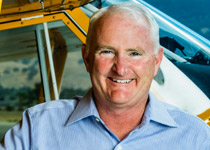 This year has not yet come to a close, but my mind is on January 1, 2020. That’s when the FAA has mandated that aircraft must be equipped for ADS-B Out in order to operate in airspace where a Mode C transponder is required today.
This year has not yet come to a close, but my mind is on January 1, 2020. That’s when the FAA has mandated that aircraft must be equipped for ADS-B Out in order to operate in airspace where a Mode C transponder is required today.
If you own an airplane, you’ve probably been following this issue pretty closely. And if you’re like most of the aviation community, you’re wondering just what equipment you need, when you should buy it, and whether it will be worth the cost to purchase and install.
The Department of Transportation’s Inspector General recently released a follow-up report citing big problems with the implementation of ADS-B, including cost overruns, delays, and lack of benefits.
The findings in the report mirror many of the issues AOPA has raised from day one. We’ve said that the benefits need to be clear if we want the general aviation community to invest the minimum $5,000 to $6,000 per aircraft to buy and install required equipment.
The good news is that the report can serve as a springboard for some collaborative problem solving. The FAA announced an October 28 summit to discuss the challenges around ADS-B implementation, and AOPA is among the organizations that have been invited. It’s clear from the Inspector General’s report that changes to the implementation process are badly needed, and I, for one, look forward to working with the FAA to come up with solutions that address issues like cost to equip and portability, which would offer greater flexibility in addressing ADS-B equipage. In parts of the country where ADS-B is up and running and participation levels are high, it can offer pilots situational awareness.
Unfortunately, that’s not in most places. Although the FAA has deployed 634 ground-based radio stations in support of ADS-B, it has identified coverage gaps that could require another 200 radio stations. And the FAA continues to experience technical glitches and hazards that were identified in previous tests of the system but haven’t been resolved. In addition, the FAA must upgrade automation systems at more than 230 air traffic control facilities before the ADS-B ground infrastructure will provide benefits. Those upgrades will not be completed before 2019 at the earliest, according to the report.
For the time being, at least, ADS-B In—the element of the system with the potential to offer direct benefits to pilots by bringing weather and traffic information into the cockpit—can be used for “advisory purposes only,” severely limiting its usefulness.
AOPA has concerns about the integrity of ADS-B data collection. We reported one incident where a pilot using ADS-B information was cited for airspace violations—a fact that was noted in the Inspector General’s report, which identified eight incidents of problems with ADS-B In data. The problems cited in the report are not with the ADS-B per se. Nor are they with the equipment used in the cockpit. The problems lie in the implementation process. We need the FAA to pause, listen carefully to what users need from the system, and work with the user community to put it all together.
AOPA has supported the move from ground-based to satellite-based navigation. That’s the promise of NextGen modernization, and ADS-B is an integral part of that effort. But making it work means giving end users—pilots like us—clear benefits, cost-effective solutions, and the flexibility to meet the realities of the way we fly. As the situation stands, installing mandated ADS-B Out equipment will allow you to fly in exactly the same way in exactly the same airspace you use today. If you add ADS-B In capabilities, which are not part of the mandate, you’ll get traffic and weather information in the cockpit, but the requirements for ADS-B In are still evolving, and no one can say for certain what the FAA ultimately will demand. So it’s really no surprise that pilots and aircraft owners aren’t rushing to equip.
Even so, the GA community is ahead of the airlines. The FAA estimates only about 3 percent of major air carriers and 10 percent of the general aviation fleet will be equipped for ADS-B Out by the end of the 2014 fiscal year. Those low numbers are a result of factors that include the FAA’s inability to provide advanced services and the high cost to equip aircraft, the report suggests.
If you’re more confused than ever, you’re not alone. AOPA members often ask us exactly when and how they should equip to meet the mandate. There’s no one-size-fits-all solution. Where, how, why, and what you fly all play a role in that decision. We will work with the FAA and the aviation community to push for more flexible solutions that let pilots and aircraft owners match their needs with the needs of a modernized air traffic system at the lowest cost we can help develop.
AOPA PresidentMark Baker is an active general aviation pilot who has logged more than 7,500 flight hours.
Email [email protected]



